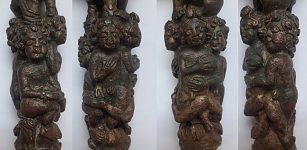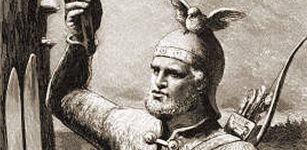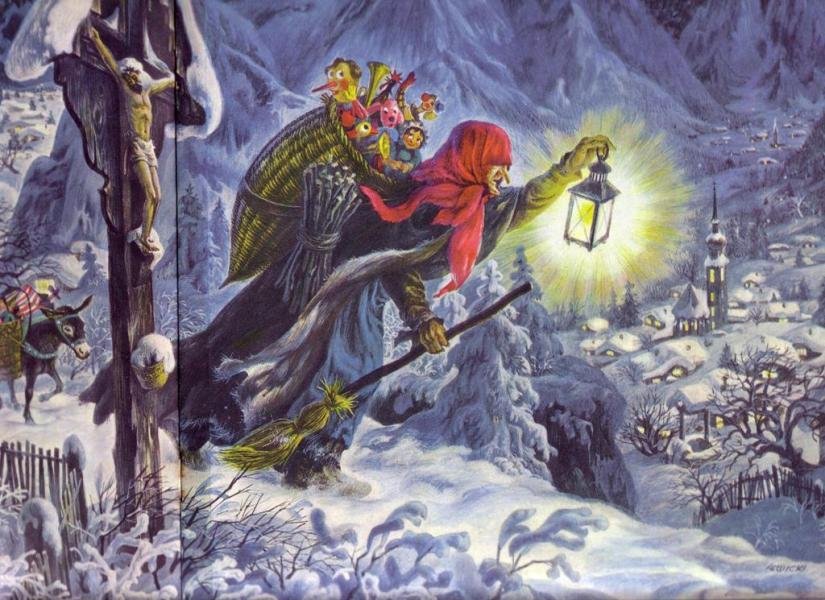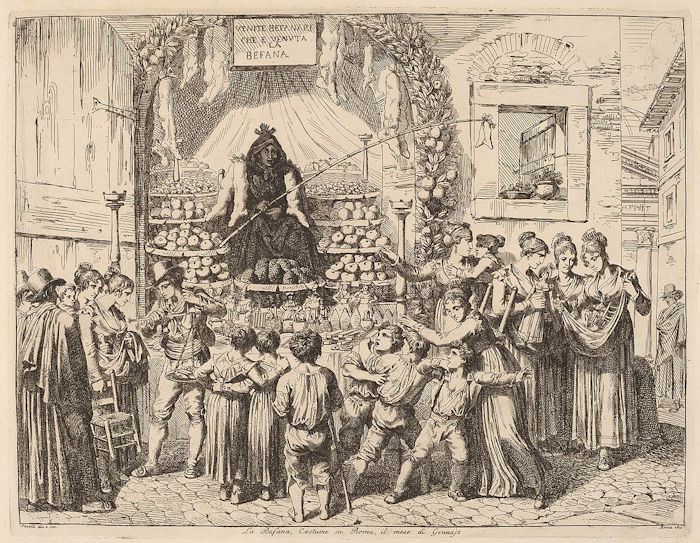Beautiful Legend Of La Befana – Witch Who Delivers Gifts To Children In Italy On Epiphany – Twelve Days After Christmas
Ellen Lloyd - AncientPages.com - In most countries, children await the arrival of St. Nicolaus or Santa Claus, who will bring them gifts. In Italy, children eagerly count the days to the coming of La Befana on Epiphany, the Twelfth Night of Christmas. La Befana is a good broomstick-riding witch who delivers gifts to children.
La Befana has been an Italian Christmas tradition since the eighth century and is celebrated every year on January 6.
La Befana, the Italian Epiphany witch. Painting by James Lewicki, from "The Golden Book of Christmas Tales" 1956. Credit: Public Domain
The Witch reminds of Baba Yaga, an enigmatic and powerful mythological figure in Slavic folklore. Both women are old, dressed in rags and a pointed hat, and have crooked noses. However, that's where the similarities end. While Baba Yaga was bribing children, La Befana gave them gifts.
It is said that La Befana is often accompanied by a black cat or a flock of birds.
According to the legend, La Befana was approached by the Biblical Magi, also known as the Three Wise Men, a few days before the birth of Jesus Christ.
La Befana is celebrated in Italy every year. Painting La Befana by Bartolomeo Pinelli (1821). Credit: Public Domain
The Three Wise Men had seen the star in the sky (today known as the Bethlehem star) and wondered if La Befana could tell them how to find the Son of God, but the Witch did not know the directions.
Being the best housekeeper in the village, she sheltered them for the night. The Biblical Magi stayed in her humble but cozy cottage, and the following day, they invited her to join them on the journey to find the baby, Jesus.
The Witch said she couldn't because she was busy cleaning her home, but she changed her mind after the Three Wise Men had left.
She quickly filled a basket with gifts for baby Jesus and went trying to find the Biblical Magi and the newborn child. But although she followed the same star, she couldn't find baby Jesus.
So, to this day, La Befana is still searching every house for the child, leaving toys, candies, and chocolates for the good children and just coal, onions, or garlic for the kids who misbehave.
The name Befana is closely related to the date of the holiday - etymologically, it comes from the Greek epiphaneia hiera '(Festival of Revelation), Latin. epiphania, and Epiphany in Italian, later passed over to Beffania to remember Strega di Beffania (the Witch of the Holy Revelation).
The feast of the Epiphany, the Epiphany, is celebrated by the Catholic Church on January 6 in Italy. It is the day that marks the end of the Christmas and New Year period.
Befana is symbolically interpreted as the personification of the old year that ends after Christmas. This is the story behind why gifts are delivered on January 6.
The Befana is celebrated throughout Italy and has become a national icon. There are festivals in her honor, and Urbania is considered her official home.
Updated on December 23, 2023
Written by Ellen Lloyd – AncientPages.com
Copyright © AncientPages.com All rights reserved. This material may not be published, broadcast, rewritten or redistributed in whole or part without the express written permission of AncientPages.com
Expand for referencesClaudio Corvino, Erberto Petoia, Storia e leggende di Babbo Natale e della Befana, Newton Compton, 1999
More From Ancient Pages
-
 Elongated Skulls: Did Intentional And Intriguing Ancient Tradition Originate In China?
Archaeology | Jul 5, 2019
Elongated Skulls: Did Intentional And Intriguing Ancient Tradition Originate In China?
Archaeology | Jul 5, 2019 -
 Zerzura – Lost Ancient Sahara Oasis Guarded By Black Giants
Featured Stories | Jun 10, 2020
Zerzura – Lost Ancient Sahara Oasis Guarded By Black Giants
Featured Stories | Jun 10, 2020 -
 Prastio-Mesorotsos Excavations: Neolithic oven prepared food for 200 guests
News | Aug 30, 2015
Prastio-Mesorotsos Excavations: Neolithic oven prepared food for 200 guests
News | Aug 30, 2015 -
 On This Day In History: Favorite Ship Of King Henry VIII ‘Mary Rose’ Sank – On July 19, 1545
News | Jul 19, 2016
On This Day In History: Favorite Ship Of King Henry VIII ‘Mary Rose’ Sank – On July 19, 1545
News | Jul 19, 2016 -
 Astronomically Aligned Temples And Pyramids Of Ancient World
Featured Stories | Dec 10, 2021
Astronomically Aligned Temples And Pyramids Of Ancient World
Featured Stories | Dec 10, 2021 -
 What Was Life For Ancient Viking Children?
Ancient History Facts | Nov 1, 2016
What Was Life For Ancient Viking Children?
Ancient History Facts | Nov 1, 2016 -
 Roman ‘Backwater’ Challenges Major Assumptions About The Ancient Empire’s Decline
Archaeology | Dec 12, 2023
Roman ‘Backwater’ Challenges Major Assumptions About The Ancient Empire’s Decline
Archaeology | Dec 12, 2023 -
 The Chinese Nostradamus And His Striking Predictions
Featured Stories | Sep 15, 2018
The Chinese Nostradamus And His Striking Predictions
Featured Stories | Sep 15, 2018 -
 Takshashila: Renowned Learning Center That Attracted Buddhist Masters, Disciples And Students Of The World
Featured Stories | Sep 13, 2021
Takshashila: Renowned Learning Center That Attracted Buddhist Masters, Disciples And Students Of The World
Featured Stories | Sep 13, 2021 -
 Science Unravels Some Secrets Of Mysterious Shipwreck Gribshunden
Archaeology | Sep 17, 2022
Science Unravels Some Secrets Of Mysterious Shipwreck Gribshunden
Archaeology | Sep 17, 2022 -
 History Shows: Taxes And Bureaucracy Are Cornerstones Of Democracy
Archaeology | Feb 18, 2021
History Shows: Taxes And Bureaucracy Are Cornerstones Of Democracy
Archaeology | Feb 18, 2021 -
 On This Day In History: Great Fire Of London Ends – On Sep 5/6, 1666
News | Sep 5, 2016
On This Day In History: Great Fire Of London Ends – On Sep 5/6, 1666
News | Sep 5, 2016 -
 Hephaestus (Hephaistos) – God Of Fire And Master Craftsman Constructed Talos, First Greek Robot And Divine Weapons Of The Gods
Featured Stories | Jul 7, 2018
Hephaestus (Hephaistos) – God Of Fire And Master Craftsman Constructed Talos, First Greek Robot And Divine Weapons Of The Gods
Featured Stories | Jul 7, 2018 -
 Secret Ancient World Buried Under The Vast Takla Makan Desert
Featured Stories | Jun 1, 2020
Secret Ancient World Buried Under The Vast Takla Makan Desert
Featured Stories | Jun 1, 2020 -
 Hesperides – Greek Nymphs Who Guarded Fabled Garden With Divine Apples Of Immortality
Featured Stories | Jun 4, 2020
Hesperides – Greek Nymphs Who Guarded Fabled Garden With Divine Apples Of Immortality
Featured Stories | Jun 4, 2020 -
 On This Day In History: Roman Emperor Caligula Was Born – On August 31, 12 AD
News | Aug 31, 2016
On This Day In History: Roman Emperor Caligula Was Born – On August 31, 12 AD
News | Aug 31, 2016 -
 Roman Britain Executions Revealed – New Evidence
Archaeology | Aug 14, 2021
Roman Britain Executions Revealed – New Evidence
Archaeology | Aug 14, 2021 -
 Strange Engraving Made By Knights Templar In French Village – Riddle Of The Rod – Part 1
Featured Stories | Oct 7, 2019
Strange Engraving Made By Knights Templar In French Village – Riddle Of The Rod – Part 1
Featured Stories | Oct 7, 2019 -
 Enmerkar: Legendary Sumerian Founder And Ruler Of Uruk And Grandson Of God Utu
Featured Stories | Mar 23, 2020
Enmerkar: Legendary Sumerian Founder And Ruler Of Uruk And Grandson Of God Utu
Featured Stories | Mar 23, 2020 -
 Ullr – Famous Norse Archer – God Of Asgard And Fastest Skier Ever Known Who Taught People The Art
Featured Stories | Jan 10, 2020
Ullr – Famous Norse Archer – God Of Asgard And Fastest Skier Ever Known Who Taught People The Art
Featured Stories | Jan 10, 2020


